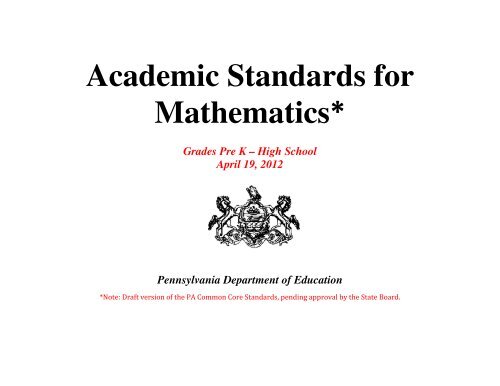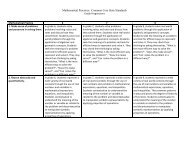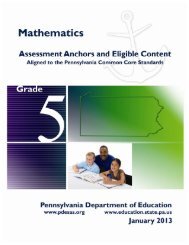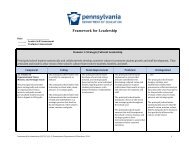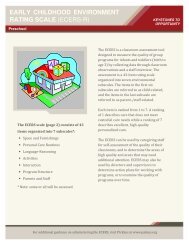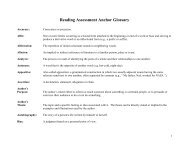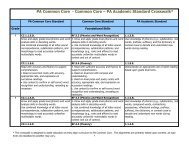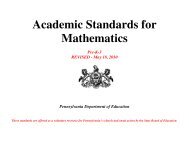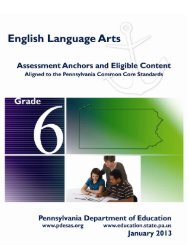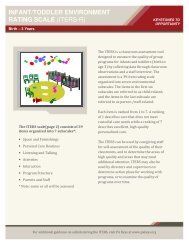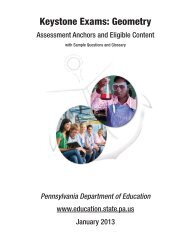Academic Standards for Mathematics Grades PreK - SAS
Academic Standards for Mathematics Grades PreK - SAS
Academic Standards for Mathematics Grades PreK - SAS
You also want an ePaper? Increase the reach of your titles
YUMPU automatically turns print PDFs into web optimized ePapers that Google loves.
<strong>Academic</strong> <strong>Standards</strong> <strong>for</strong><strong>Mathematics</strong>*<strong>Grades</strong> Pre K – High SchoolApril 19, 2012Pennsylvania Department of Education*Note: Draft version of the PA Common Core <strong>Standards</strong>, pending approval by the State Board.
Pennsylvania Common Core <strong>Standards</strong><strong>Mathematics</strong>INTRODUCTIONThe Pennsylvania Common Core <strong>Standards</strong> in <strong>Mathematics</strong> in grades <strong>PreK</strong>-5 lay a solid foundation in whole numbers, addition, subtraction,multiplication, division, fractions, and decimals. Taken together, these elements support a student’s ability to learn and apply more demanding mathconcepts and procedures. The middle school and high school standards call on students to practice applying mathematical ways of thinking to realworld issues and challenges; they prepare students to think and reason mathematically. Additionally, they set a rigorous definition of college andcareer readiness by demanding that students develop a depth of understanding and ability to apply mathematics to novel situations, as collegestudents and employees regularly do. Although the standards are not a curriculum or a prescribed series of activities, school entities will use themto develop a local school curriculum that will meet local students’ needs.This document includes PA Common Core <strong>Standards</strong> <strong>for</strong> <strong>Mathematics</strong> Content and Mathematical Practice. The mathematics standards definewhat students should understand and be able to do. Mathematical Practice <strong>Standards</strong> describes the habits of mind required to reach a level ofmathematical proficiency.<strong>Standards</strong> <strong>for</strong> Mathematical Content2.1 Numbers and OperationsA) Counting and CardinalityB) Number and Operations in Base TenC) Number and Operations—FractionsD) Ratios and Proportional RelationshipsE) The Number SystemF) Number and Quantity2.2 Algebraic ConceptsA) Operations and Algebra ThinkingB) Expressions & EquationsC) FunctionsD) Algebra2.3 GeometryA) Geometry2.4 Measurement, Data and ProbabilityA) Measurement and DataB) Statistics and ProbabilityPA Common Core <strong>Standards</strong>Mathematical Content and Mathematical Practice<strong>Standards</strong> <strong>for</strong> Mathematical Practice• Make sense of problems and persevere in solving them.• Reason abstractly and quantitatively.• Construct viable arguments and critique the reasoning of others.• Model with mathematics.• Use appropriate tools strategically.• Attend to precision.• Look <strong>for</strong> and make use of structure.• Look <strong>for</strong> and make sense of regularity in repeated reasoning.DRAFT Date 4-19-12| P a g e 2
Pennsylvania Common Core <strong>Standards</strong><strong>Mathematics</strong><strong>Standards</strong> cannot be viewed or addressed in isolation, as each standard depends upon or may lead into multiple standards across grades; thus, it isimperative that educators are familiar with both the standards that come be<strong>for</strong>e and those that follow a particular grade level. These revised standardsreflect instructional shifts that cannot occur without the integrated emphasis on content and practice.<strong>Standards</strong> are overarching statements of what a proficient math student should know and be able to do. The Pennsylvania Assessment Anchors andEligible Content closely align with the revised standards and are an invaluable source <strong>for</strong> greater detail.Key Points in <strong>Mathematics</strong>• The standards stress both procedural skills and conceptual understanding to ensure students are learning and applying the criticalin<strong>for</strong>mation they need to succeed at higher levels.• K-5 standards provide students with a solid foundation in whole numbers, addition, subtraction, multiplication, division, fractions, anddecimals—which help young students build the foundation to successfully apply more demanding math concepts and procedures, andmove into application. They also provide detailed guidance to teachers on how to navigate their way through topics such as fractions,negative numbers, and geometry and do so by maintaining a continuous progression from grade to grade.• Having built a strong foundation at K-5, students can do hands on learning in geometry, algebra, and probability and statistics. Studentswho have mastered the content and skills through the seventh grade will be well-prepared <strong>for</strong> algebra in grade 8.• High school standards emphasize practicing applying mathematical ways of thinking to real world issues and challenges.DRAFT Date 4-19-12| P a g e 3
Pennsylvania Common Core <strong>Standards</strong><strong>Mathematics</strong>The PA Common Core <strong>Standards</strong> <strong>for</strong> <strong>Mathematics</strong> detail four standard areas: Numbers and Operations, Algebraic Concepts, Geometry, and DataAnalysis and Probability. These standard areas are reflective of the reporting categories in the PA Common Core Assessment Anchors and EligibleContent. The intent of this document is to provide a useful tool <strong>for</strong> designing curriculum, instruction, and assessment. The grade level curriculum andinstructional shifts in mathematics cannot occur without the integrated emphasis on content and practice. The chart below illustrates the fourstandard areas and the development and progression of the strands, with an understanding that all is framed around the <strong>Standards</strong> <strong>for</strong> MathematicalPractice.Mathematical <strong>Standards</strong>: Development and Progression<strong>Standards</strong> <strong>for</strong> Mathematical PracticeMake sense of problems and persevere in solving them.Construct viable arguments and critique the reasoning of others.Use appropriate tools strategically.Look <strong>for</strong> and make use of structure.Reason abstractly and quantitatively.Model with mathematics.Attend to precision.Look <strong>for</strong> and express regularity in repeated reasoning.Pre K K 1 2 3 4 5 6 7 8 HS2.1Numbers andOperations(A) Counting &Cardinality(B) Number and Operations in Base Ten(C) Number and Operations -Fractions(D) Ratios andProportionalRelationships(E) The Number System(F) Numberand Quantity2.2AlgebraicConcepts2.3Geometry(A) Operations and Algebraic Thinking (B) Expressions and Equations (D) Algebra(A) Geometry(C) Functions2.4Measurement,Data andProbability(A) Measurement and Data(B) Statistics and ProbabilityDRAFT Date 4-19-12| P a g e 4
Pennsylvania Common Core <strong>Standards</strong><strong>Mathematics</strong>2.1 Numbers and OperationsThe <strong>Standards</strong> of Mathematical PracticesMake sense of problems and persevere in solving them. Reason abstractly and quantitatively.Construct viable arguments and critique the reasoning of others. Model with mathematics.Use appropriate tools strategically. Attend to precision.Look <strong>for</strong> and make use of structure. Look <strong>for</strong> and express regularity in repeated reasoning.2.1.PREK Grade<strong>PreK</strong>Grade K2.1.KGrade 12.1.1Grade 22.1.2Grade 32.1.3Grade 42.1.4Pennsylvania’s public schools shall teach, challenge and support every student to realize his or her maximum potential and to acquire the knowledge and skills needed to:(A) Counting &Cardinality(B) Number & Operations in Base TenCC.2.1.PREK.A.1Know number namesand the count sequence.CC.2.1.PREK.A.2Count to tell the numberof objects.CC.2.1.PREK.A.3Compare numbers.Intentionally BlankCC.2.1.K.A.1Know number names andwrite and recite the countsequence.CC.2.1.K.A.2Apply one-to onecorrespondence to countthe number of objects.CC.2.1.K.A.3Apply the concept ofmagnitude to comparenumbers and quantities.CC.2.1.K.B.1Use place value tocompose and decomposenumbers within 19.Intentionally BlankGrade 52.1.5Intentionally Blank Intentionally Blank Intentionally Blank Intentionally Blank Intentionally BlankCC.2.1.1.B.1Extend the countingsequence to read andwrite numerals torepresent objects.CC.2.1.1.B.2Use place value conceptsto represent amounts oftens and ones and tocompare two digitnumbers.CC.2.1.1.B.3Use place value conceptsand properties ofoperations to add andsubtract within 100.CC.2.1.2.B.1Use place valueconcepts to representamounts of tens andones and to comparethree digit numbers.CC.2.1.2.B.2Use place valueconcepts to read,write and skip countto 1000.CC.2.1.2.B.3Use place valueunderstanding andproperties ofoperations to add andsubtract within 1000.CC.2.1.3.B.1Apply place valueunderstanding andproperties of operationsto per<strong>for</strong>m multi-digitarithmetic.M03.A-T.1.1.1M03.A-T.1.1.2M03.A-T.1.1.3M03.A-T.1.1.4Intentionally BlankCC.2.1.4.B.1Apply place valueconcepts to show anunderstanding of multidigitwhole numbers.M04.A-T.1.1.1M04.A-T.1.1.2M04.A-T.1.1.3M04.A-T.1.1.4CC.2.1.4.B.2Use place valueunderstanding andproperties of operationsto per<strong>for</strong>m multi-digitarithmetic.M04.A-T.2.1.1M04.A-T.2.1.2M04.A-T.2.1.3M04.A-T.2.1.4CC.2.1.5.B.1Apply place valueconcepts to show anunderstanding ofoperations and roundingas they pertain to wholenumbers and decimals.M05.A-T.1.1.1M05.A-T.1.1.2M05.A-T.1.1.3M05.A-T.1.1.4M05.A-T.1.1.5CC.2.1.5.B.2Extend an understandingof operations with wholenumbers to per<strong>for</strong>moperations includingdecimals.M05.A-T.2.1.1M05.A-T.2.1.2M05.A-T.2.1.3Intentionally Blank Intentionally Blank Intentionally BlankDRAFT Date 4-19-12| P a g e 5
Pennsylvania Common Core <strong>Standards</strong><strong>Mathematics</strong>2.1 Numbers and OperationsThe <strong>Standards</strong> of Mathematical PracticesMake sense of problems and persevere in solving them. Reason abstractly and quantitatively.Construct viable arguments and critique the reasoning of others. Model with mathematics.Use appropriate tools strategically. Attend to precision.Look <strong>for</strong> and make use of structure. Look <strong>for</strong> and express regularity in repeated reasoning.Grade <strong>PreK</strong>2.1.PREKGrade K2.1.KGrade 12.1.1Pennsylvania’s public schools shall teach, challenge and support every student to realize his or her maximum potential and to acquire the knowledge and skills needed to:(C) Number & Operations - FractionsGrade 22.1.2Intentionally Blank Intentionally Blank Intentionally Blank Intentionally BlankGrade 32.1.3CC.2.1.3.C.1Explore and develop anunderstanding offractions as numbers.M03.A-F.1.1.1M03.A-F.1.1.2M03.A-F.1.1.3M03.A-F.1.1.4M03.A-F.1.1.5Intentionally BlankIntentionally BlankGrade 42.1.4CC.2.1.4.C.1Extend theunderstanding offractions to showequivalence andordering.M04.A-F.1.1.1M04.A-F.1.1.2CC.2.1.4.C.2Build fractions fromunit fractions byapplying and extendingpreviousunderstandings ofoperations on wholenumbers.M04.A-F.2.1.1M04.A-F.2.1.2M04.A-F.2.1.3M04.A-F.2.1.4M04.A-F.2.1.5M04.A-F.2.1.6M04.A-F.2.1.7CC.2.1.4.C.3Connect decimalnotation to fractions,and compare decimalfractions (base 10denominator, e.g.,19/100).M04.A-F.3.1.1M04.A-F.3.1.2M04.A-F.3.1.3Grade 52.1.5CC.2.1.5.C.1Use the understanding ofequivalency to add andsubtract fractions.M05.A-F.1.1.1CC.2.1.5.C.2Apply and extendprevious understandingsof multiplication anddivision to multiply anddivide fractions.M05.A-F.2.1.1M05.A-F.2.1.2M05.A-F.2.1.3M05.A-F.2.1.4Intentionally BlankDRAFT Date 4-19-12| P a g e 6
2.2 Algebraic ConceptsPennsylvania Common Core <strong>Standards</strong><strong>Mathematics</strong>The <strong>Standards</strong> of Mathematical PracticesMake sense of problems and persevere in solving them. Reason abstractly and quantitatively.Construct viable arguments and critique the reasoning of others. Model with mathematics.Use appropriate tools strategically. Attend to precision.Look <strong>for</strong> and make use of structure. Look <strong>for</strong> and express regularity in repeated reasoning.Grade <strong>PreK</strong>2.2.PREKGrade K2.2.KGrade 12.2.1Pennsylvania’s public schools shall teach, challenge and support every student to realize his or her maximum potential and to acquire the knowledge and skills needed to:CC.2.2.PREK.A.1Understand addition asputting together andadding to, andunderstand subtractionas taking apart andtaking from.CC.2.2.K.A.1Extend the concepts ofputting together andtaking apart to add andsubtract within 10.CC.2.2.1.A.1Represent and solveproblems involvingaddition andsubtraction within 20.Grade 22.2.2CC.2.2.2.A.1Represent and solveproblems involvingaddition andsubtraction within100.Grade 32.2.3CC.2.2.3.A.1Represent and solveproblems involvingmultiplication anddivision.Grade 42.2.4CC.2.2.4.A.1Represent and solveproblems involving thefour operations.Grade 52.2.5CC.2.2.5.A.1Interpret and evaluatenumerical expressionsusing order of operations.(A) Operations and Algebraic ThinkingIntentionally BlankIntentionally BlankCC.2.2.1.A.2Understand and applyproperties ofoperations and therelationship betweenaddition andsubtraction.Intentionally Blank Intentionally Blank Intentionally BlankCC.2.2.2.A.2Use mentalstrategies to addand subtract within20.CC.2.2.2.A.3Work with equalgroups of objects togain foundations <strong>for</strong>multiplication.Intentionally Blank Intentionally Blank Intentionally Blank Intentionally BlankM03.B-O.1.1.1M03.B-O.1.1.2M03.B-O.1.2.1M03.B-O.1.2.2CC.2.2.3.A.2Understand propertiesof multiplication and therelationship betweenmultiplication anddivision.M03.B-O.2.1.1M03.B-O.2.1.2M03.B-O.2.2.1CC.2.2.3.A.3Demonstratemultiplication anddivision fluency.CC.2.2.3.A.4Solve problemsinvolving the fouroperations, and identifyand explain patterns inarithmetic.M03.B-O.3.1.1M03.B-O.3.1.2M03.B-O.3.1.3M03.B-O.3.1.4M03.B-O.3.1.5M03.B-O.3.1.6M03.B-O.3.1.7M04.B-O.1.1.1M04.B-O.1.1.2M04.B-O.1.1.3M04.B-O.1.1.4CC.2.2.4.A.2Develop and/or applynumber theory conceptsto find factors andmultiples.M04.B-O.2.1.1Intentionally BlankCC.2.2.4.A.4Generate and analyzepatterns using onerule.M04.B-O.3.1.1M04.B-O.3.1.2M04.B-O.3.1.3M05.B-O.1.1.1M05.B-O.1.1.2Intentionally BlankIntentionally BlankCC.2.2.5.A.4Analyze patterns andrelationships using tworules.M05.B-O.2.1.1M05.B-O.2.1.2| P a g e 7DRAFT Date 4-19-12
Pennsylvania Common Core <strong>Standards</strong><strong>Mathematics</strong>2.3 GeometryThe <strong>Standards</strong> of Mathematical PracticesMake sense of problems and persevere in solving them. Reason abstractly and quantitatively.Construct viable arguments and critique the reasoning of others. Model with mathematics.Use appropriate tools strategically. Attend to precision.Look <strong>for</strong> and make use of structure. Look <strong>for</strong> and express regularity in repeated reasoning.Grade <strong>PreK</strong>2.3.PRE KGrade K2.3.KGrade 12.3.1Grade 22.3.2Grade 32.3.3Grade 42.3.4Grade 52.3.5Pennsylvania’s public schools shall teach, challenge and support every student to realize his or her maximum potential and to acquire the knowledge and skills needed to:(A) GeometryCC.2.3.PREK.A.1Identify and describeshapes.CC.2.3.PREK.A.2Analyze, compare,create, and composeshapes.CC.2.3.K.A.1Identify and describetwo- and threedimensionalshapes.CC.2.3.K.A.2Analyze, compare,create, and composetwo- and threedimensionalshapes.CC.2.3.1.A.1Compose anddistinguish betweentwo- and threedimensionalshapesbased on theirattributes.CC.2.3.1.A.2Use the understandingof fractions to partitionshapes into halves andquarters.CC.2.3.2.A.1Analyze and drawtwo- and threedimensionalshapeshaving specifiedattributes.CC.2.3.2.A.2Use theunderstanding offractions to partitionshapes into halves,quarters, and thirds.CC.2.3.3.A.1Identify, compare, andclassify shapes andtheir attributes.M03.C-G.1.1.1M03.C-G.1.1.2CC.2.3.3.A.2Use the understandingof fractions to partitionshapes into parts withequal areas andexpress the area ofeach part as a unitfraction of the whole.M03.C-G.1.1.3CC.2.3.4.A.1Draw lines and anglesand identify these intwo-dimensionalfigures.M04.C-G.1.1.1CC.2.3.4.A.2Classify twodimensionalfiguresby properties of theirlines and angles.M04.C-G.1.1.2CC.2.3.4.A.3Recognize symmetricshapes and drawlines of symmetry.M04.C-G.1.1.3CC.2.3.5.A.1Graph points in the firstquadrant on thecoordinate plane andinterpret these pointswhen solving real worldand mathematicalproblems.M05.C-G.1.1.1M05.C-G.1.1.2CC.2.3.5.A.2Classify twodimensionalfigures intocategories based on anunderstanding of theirproperties.M05.C-G.2.1.1DRAFT Date 4-19-12| P a g e 8
Pennsylvania Common Core <strong>Standards</strong><strong>Mathematics</strong>2.4 Measurement, Data and ProbabilityThe <strong>Standards</strong> of Mathematical PracticesMake sense of problems and persevere in solving them. Reason abstractly and quantitatively.Construct viable arguments and critique the reasoning of others. Model with mathematics.Use appropriate tools strategically. Attend to precision.Look <strong>for</strong> and make use of structure. Look <strong>for</strong> and express regularity in repeated reasoning.Grade <strong>PreK</strong>2.4.PREKGrade K2.4.KGrade 12.4.1Grade 22.4.2Grade 32.4.3Grade 42.4.4Grade 52.4.5Pennsylvania’s public schools shall teach, challenge and support every student to realize his or her maximum potential and to acquire the knowledge and skills needed to:CC.2.4.PREK.A.1CC.2.4.K.A.1CC.2.4.1.A.1CC.2.4.2.A.1CC.2.4.3.A.1CC.2.4.4.A.1CC.2.4.5.A.1Describe and compare Describe and compare Order lengths and Measure and estimate Solve problems involving Solve problemsSolve problems usingmeasurable attributes attributes of length, measure them both lengths in standard measurement and involving measurement conversions within aof length and weights area, weight, and indirectly and byunits usingestimation ofand conversions from a given measurementof everyday objects. capacity of everyday repeating length units. appropriate tools. temperature, liquid larger unit to a smaller system.objects.volume, mass or length. unit.(A)Measurement and DataIntentionally BlankIntentionally BlankCC.2.4.1.A.2Tell and write time tothe nearest half hourusing both analog anddigital clocks.Intentionally Blank Intentionally Blank Intentionally BlankCC.2.4.2.A.2Tell and write time tothe nearest fiveminutes using bothanalog and digitalclocks.CC.2.4.2.A.3Solve problems usingcoins and papercurrency withappropriate symbols.M03.D-M.1.2.1M03.D-M.1.2.2M03.D-M.1.2.3CC.2.4.3.A.2Tell and write time to thenearest minute and solveproblems by calculatingtime intervals.M03.D-M.1.1.1M03.D-M.1.1.2CC.2.4.3.A.3Solve problems and makechange involving moneyusing a combination ofcoins and bills.M03.D-M.1.3.1M03.D-M.1.3.2M03.D-M.1.3.3M04.D-M.1.1.1M04.D-M.1.1.2M04.D-M.1.1.3M04.D-M.1.1.4CC.2.4.4.A.2Translate in<strong>for</strong>mationfrom one type of datadisplay to another.M05.D-M.1.1.1CC.2.4.5.A.2Represent and interpretdata using appropriatescale.M04.D-M.2.1.3M05.D-M.2.1.2Intentionally Blank Intentionally Blank| P a g e 9DRAFT Date 4-19-12
Pennsylvania Common Core <strong>Standards</strong><strong>Mathematics</strong>2.4 Measurement, Data and ProbabilityThe <strong>Standards</strong> of Mathematical PracticesMake sense of problems and persevere in solving them. Reason abstractly and quantitatively.Construct viable arguments and critique the reasoning of others. Model with mathematics.Use appropriate tools strategically. Attend to precision.Look <strong>for</strong> and make use of structure. Look <strong>for</strong> and express regularity in repeated reasoning.Grade <strong>PreK</strong> 2.4.K Grade K Grade 12.4.2 Grade 2 2.4.3 Grade 3 2.4.4 Grade 4 2.4.5 Grade 52.4.PREK2.4.1Pennsylvania’s public schools shall teach, challenge and support every student to realize his or her maximum potential and to acquire the knowledge and skills needed to:CC.2.4.PREK.A.4CC.2.4.K.A.4CC.2.4.1.A.4CC.2.4.2.A.4CC.2.4.4.A.4CC.2.4.5.A.4Classify objects and Classify objects and Represent and interpret Represent andRepresent and interpret Solve problems involvingcount the number of count the number of data using tables/charts. interpret data usingdata involving fractions computation of fractionsobjects in eachobjects in eachline plots, pictureusing in<strong>for</strong>mation using in<strong>for</strong>mationcategory.category.graphs, and bar graphs.provided in a line plot. provided in a line plot.(A) Measurement and DataIntentionally Blank Intentionally Blank Intentionally BlankIntentionally BlankCC.2.4.2.A.6Extend the concepts ofaddition andsubtraction toproblems involvinglength.CC.2.4.3.A.4Represent and interpretdata using tally charts,tables, pictographs, lineplots, and bar graphs.M03.D-M.2.1.1M03.D-M.2.1.2M03.D-M.2.1.3M03.D-M.2.1.4CC.2.4.3.A.5Determine the area of arectangle and apply theconcept tomultiplication and toaddition.M03.D-M.3.1.1M03.D-M.3.1.2CC.2.4.3.A.6Solve problemsinvolving perimeters ofpolygons anddistinguish betweenlinear and areameasures.M03.D-M.4.1.1M04.D-M.2.1.1M04.D-M.2.1.2Intentionally BlankCC.2.4.4.A.6Measure angles and useproperties of adjacentangles to solveproblems.M04.D-M.3.1.1M04.D-M.3.1.2M05.D-M.2.1.1CC.2.4.5.A.5Apply concepts of volumeto solve problems andrelate volume tomultiplication and toaddition.M05.D-M.3.1.1M05.D-M.3.1.2| P a g e 10DRAFT Date 4-19-12
Pennsylvania Common Core <strong>Standards</strong><strong>Mathematics</strong>2.1. Numbers and OperationsThe <strong>Standards</strong> of Mathematical PracticesMake sense of problems and persevere in solving them. Reason abstractly and quantitatively.Construct viable arguments and critique the reasoning of others. Model with mathematics.Use appropriate tools strategically. Attend to precision.Look <strong>for</strong> and make use of structure. Look <strong>for</strong> and express regularity in repeated reasoning.2.1.6 Grade 6 2.1.7 Grade 7 2.1.8 Grade 8 2.1.HS High SchoolPennsylvania’s public schools shall teach, challenge and support every student to realize his or her maximum potential and to acquire the knowledge and skills needed to:(D) Ratios & ProportionalRelationships(E) The Number SystemCC.2.1.6.D.1Understand ratioconcepts and use ratioreasoning to solveproblems.M06.A-R.1.1.1M06.A-R.1.1.2M06.A-R.1.1.3M06.A-R.1.1.4M06.A-R.1.1.5CC.2.1.6.E.1Apply and extendpreviousunderstandings ofmultiplication anddivision to dividefractions by fractions.M06.A-N.1.1.1CC.2.1.6.E.2Identify and chooseappropriate processes tocompute fluently withmulti-digit numbers.M06.A-N.2.1.1CC.2.1.6.E.3Develop and/or applynumber theory conceptsto find common factorsand multiples.M06.A-N.2.2.1M06.A-N.2.2.2CC.2.1.7.D.1Analyze proportionalrelationships and usethem to model and solvereal-world andmathematical problems.M07.A-R.1.1.1M07.A-R.1.1.2M07.A-R.1.1.3M07.A-R.1.1.4M07.A-R.1.1.5M07.A-R.1.1.6CC.2.1.7.E.1Apply and extendpreviousunderstandings ofoperations withfractions to operationswith rational numbers.M07.A-N.1.1.1M07.A-N.1.1.2M07.A-N.1.1.3Intentionally BlankIntentionally BlankCC.2.1.8.E.1Distinguish betweenrational and irrationalnumbers using theirproperties.M08.A-N.1.1.1M08.A-N.1.1.2Intentionally Blank(F) Number and QuantityCC.2.1.HS.F.1Apply and extend the properties of exponents to solve problems with rational exponents.A1.1.1.1.1, A1.1.1.1.2, A1.1.1.3.1, A2.1.2.1.1, A2.1.2.1.2, A2.1.2.1.3, A2.1.2.1.4CC.2.1.HS.F.2Apply properties of rational and irrational numbers to solve real world or mathematicalproblems.A1.1.1.1.1, A1.1.1.1.2, A1.1.1.3.1CC.2.1.HS.F.3Apply quantitative reasoning to choose and Interpret units and scales in <strong>for</strong>mulas, graphs and datadisplays.A1.1.2.1.1, A1.1.2.1.2, A1.1.2.1.3, A1.2.1.2.1, A1.2.1.2.2, A2.2.2.1.1, A2.2.2.1.2, A2.2.2.1.3,A2.2.2.1.4, A2.2.3.1.1, A2.2.3.1.2CC.2.1.HS.F.4Use units as a way to understand problems and to guide the solution of multi-stepproblems.A1.1.2.1.1, A1.1.2.1.2, A1.1.2.1.3, A1.2.1.2.1, A1.2.1.2.2, A2.2.2.1.1, A2.2.2.1.2, A2.2.2.1.3,A2.2.2.1.4CC.2.1.HS.F.5Choose a level of accuracy appropriate to limitations on measurement when reportingquantities.A1.1.2.1.1, A1.1.2.1.2, A1.1.2.1.3, A1.1.2.2.1, A1.1.2.2.2, A1.1.3.1.1, A1.1.3.1.2, A1.1.3.1.3,A1.1.3.2.1, A1.1.3.2.2, A2.2.3.1.1, A2.2.3.1.2CC.2.1.HS.F.6Extend the knowledge of arithmetic operations and apply to complex numbers.A2.1.1.1.1, A2.1.1.1.2, A2.1.1.2.1, A2.1.1.2.2CC.2.1.HS.F.7Apply concepts of complex numbers in polynomial identities and quadratic equations tosolve problems.A2.2.1.1.1, A2.2.1.1.2, A2.2.1.1.3, A2.2.1.1.4| P a g e 11DRAFT Date 4-19-12
Pennsylvania Common Core <strong>Standards</strong><strong>Mathematics</strong>2.1. Numbers and OperationsThe <strong>Standards</strong> of Mathematical PracticesMake sense of problems and persevere in solving them. Reason abstractly and quantitatively.Construct viable arguments and critique the reasoning of others. Model with mathematics.Use appropriate tools strategically. Attend to precision.Look <strong>for</strong> and make use of structure. Look <strong>for</strong> and express regularity in repeated reasoning.2.1.6 Grade 6 2.1.7 Grade 7 2.1.8 Grade 8 2.1.HS High SchoolPennsylvania’s public schools shall teach, challenge and support every student to realize his or her maximum potential and to acquire the knowledge and skills needed to:CC.2.1.6.E.4Apply and extendprevious understandingsof numbers to the systemof rational numbers.M06.A-N.3.1.1M06.A-N.3.1.2M06.A-N.3.1.3M06.A-N.3.2.1M06.A-N.3.2.2M06.A-N.3.2.3Intentionally BlankCC.2.1.8.E.4Estimate irrationalnumbers by comparingthem to rationalnumbers.M08.A-N.1.1.3M08.A-N.1.1.4M08.A-N.1.1.5| P a g e 12DRAFT Date 4-19-12
2.2. Algebraic Concepts(B) Expressions and EquationsPennsylvania Common Core <strong>Standards</strong><strong>Mathematics</strong>The <strong>Standards</strong> of Mathematical PracticesMake sense of problems and persevere in solving them. Reason abstractly and quantitatively.Construct viable arguments and critique the reasoning of others. Model with mathematics.Use appropriate tools strategically. Attend to precision.Look <strong>for</strong> and make use of structure. Look <strong>for</strong> and express regularity in repeated reasoning.2.2.6 Grade 6 2.2.7 Grade 7 2.2.8 Grade 8 2.2.HS High SchoolPennsylvania’s public schools shall teach, challenge and support every student to realize his or her maximum potential and to acquire the knowledge and skills needed to:CC.2.2.6.B.1CC.2.2.7.B.1CC.2.2.8.B.1Apply and extend Apply properties of Apply concepts ofCC.2.2.HS.D.1previousoperations to generate radicals and integerInterpret the structure of expressions to represent a quantity in terms of its context.understandings of equivalent expressions. exponents to generateA1.1.1.5.1, A1.1.1.5.2, A1.1.1.5.3, A2.1.2.2.1, A2.1.2.2.2arithmetic to algebraicequivalent expressions.expressions.M06.B-E.1.1.1M06.B-E.1.1.2M06.B-E.1.1.3M06.B-E.1.1.4M06.B-E.1.1.5CC.2.2.6.B.2Understand the processof solving a one-variableequation or inequalityand apply to real-worldand mathematicalproblems.M06.B-E.2.1.1M06.B-E.2.1.2M06.B-E.2.1.3M06.B-E.2.1.4M07.B-E.1.1.1Intentionally BlankM08.B-E.1.1.1M08.B-E.1.1.2M08.B-E.1.1.3M08.B-E.1.1.4CC.2.2.8.B.2Understand theconnections betweenproportionalrelationships, lines, andlinear equations.M08.B-E.2.1.1M08.B-E.2.1.2M08.B-E.2.1.3(D) AlgebraCC.2.2.HS.D.2Write expressions in equivalent <strong>for</strong>ms to solve problems.A1.1.1.5.1, A1.1.1.5.2, A1.1.1.5.3, A2.1.2.1.1, A2.1.2.1.2, A2.1.2.1.3, A2.1.2.1.4, A2.1.2.2.1,A2.1.2.2.2CC.2.2.HS.D.3Extend the knowledge of arithmetic operations and apply to polynomials.A1.1.1.5.1, A1.1.1.5.2, A1.1.1.5.3, A2.1.2.2.1, A2.1.2.2.2CC.2.2.HS.D.4Understand the relationship between zeros and factors of polynomials to makegeneralizations about functions and their graphs.A2.1.2.2.1, A2.1.2.2.2CC.2.2.HS.D.5Use polynomial identities to solve problems.A1.1.1.5.1, A1.1.1.5.2, A1.1.1.5.3, A2.1.2.2.1, A2.1.2.2.2, A2.1.3.1.1, A2.1.3.1.2, A2.1.3.1.3,A2.1.3.1.4CC.2.2.HS.D.6Extend the knowledge of rational functions to rewrite in equivalent <strong>for</strong>ms.A1.1.1.5.1, A1.1.1.5.2, A1.1.1.5.3, A2.1.3.1.1, A2.1.3.1.2, A2.1.3.1.3, A2.1.3.1.4CC.2.2.HS.D.7Create and graph equations or inequalities to describe numbers or relationships.A1.1.2.1.1, A1.1.2.1.2, A1.1.2.1.3, A1.1.3.1.1, A1.1.3.1.2, A1.1.3.1.3, A2.1.3.1.1, A2.1.3.1.2,A2.1.3.1.3, A2.1.3.1.4, A2.2.2.1.1, A2.2.2.1.2, A2.2.2.1.3, A2.2.2.1.4| P a g e 13DRAFT Date 4-19-12
2.2. Algebraic ConceptsPennsylvania Common Core <strong>Standards</strong><strong>Mathematics</strong>The <strong>Standards</strong> of Mathematical PracticesMake sense of problems and persevere in solving them. Reason abstractly and quantitatively.Construct viable arguments and critique the reasoning of others. Model with mathematics.Use appropriate tools strategically. Attend to precision.Look <strong>for</strong> and make use of structure. Look <strong>for</strong> and express regularity in repeated reasoning.2.2.6 Grade 6 2.2.7 Grade 7 2.2.8 Grade 8 2.2.HS High SchoolPennsylvania’s public schools shall teach, challenge and support every student to realize his or her maximum potential and to acquire the knowledge and skills needed to:CC.2.2.6.B.3Represent and analyzequantitativerelationships betweendependent andindependent variables.CC.2.2.8.B.3Analyze and solve linearequations and pairs ofsimultaneous linearequations.CC.2.2.HS.D.8Apply inverse operations to solve equations or <strong>for</strong>mulas <strong>for</strong> a given variable.A1.1.2.1.1, A1.1.2.1.2, A1.1.2.1.3, A2.1.3.1.1, A2.1.3.1.2, A2.1.3.1.3, A2.1.3.1.4CC.2.2.7.B.3Model and solve realworldand mathematicalproblems by using andconnecting numerical,algebraic, and/orgraphicalrepresentations.CC.2.2.HS.D.9Use reasoning to solve equations and justify the solution method.A1.1.1.4.1, A1.1.2.1.1, A1.1.2.1.2, A1.1.2.1.3, A1.1.2.2.1, A1.1.2.2.2, A1.1.3.1.1, A1.1.3.1.2,A1.1.3.1.3, A2.1.3.1.1, A2.1.3.1.2, A2.1.3.1.3, A2.1.3.1.4, A2.1.3.2.1, A2.1.3.2.2M06.B-E.3.1.1M06.B-E.3.1.2M07.B-E.2.1.1M07.B-E.2.2.1M07.B-E.2.2.2M07.B-E.2.3.1M08.B-E.3.1.1M08.B-E.3.1.2M08.B-E.3.1.3M08.B-E.3.1.4M08.B-E.3.1.5CC.2.2.HS.D.10Represent, solve and interpret equations/inequalities and systems ofequations/inequalities algebraically and graphically.A1.1.2.1.1, A1.1.2.1.2, A1.1.2.1.3, A1.1.2.2.1, A1.1.2.2.2, A1.1.3.1.1, A1.1.3.1.2, A1.1.3.1.3,A1.1.3.2.1, A1.1.3.2.2, A2.1.3.1.1, A2.1.3.1.2, A2.1.3.1.3, A2.1.3.1.4| P a g e 14DRAFT Date 4-19-12
2.2. Algebraic ConceptsPennsylvania Common Core <strong>Standards</strong><strong>Mathematics</strong>The <strong>Standards</strong> of Mathematical PracticesMake sense of problems and persevere in solving them. Reason abstractly and quantitatively.Construct viable arguments and critique the reasoning of others. Model with mathematics.Use appropriate tools strategically. Attend to precision.Look <strong>for</strong> and make use of structure. Look <strong>for</strong> and express regularity in repeated reasoning.2.2.6 Grade 6 2.2.7 Grade 7 2.2.8 Grade 8 2.2.HS High SchoolPennsylvania’s public schools shall teach, challenge and support every student to realize his or her maximum potential and to acquire the knowledge and skills needed to:CC.2.2.8.C.1Define, evaluate, andcompare functions.(C) FunctionsIntentionally BlankIntentionally BlankM08.B-F.1.1.1M08.B-F.1.1.2M08.B-F.1.1.3CC.2.2.8.C.2Use concepts of functionsto model relationshipsbetween quantities.M08.B-F.2.1.1M08.B-F.2.1.2(C) FunctionsCC.2.2.HS.C.1Use the concept and notation of functions to interpret and apply them in terms of theircontext.A1.2.1.1.1, A1.2.1.1.2, A1.2.1.1.3, A1.2.2.1.1, A1.2.2.1.2, A1.2.2.1.3, A1.2.2.1.4, A2.2.1.1.1,A2.2.1.1.2, A2.2.1.1.3, A2.2.1.1.4, G.2.2.2.1, G.2.2.2.2, G.2.2.2.3, G.2.2.2.4, G.2.2.2.5CC.2.2.HS.C.2Graph and analyze functions and use their properties to make connections between thedifferent representations.A1.2.1.1.1, A1.2.1.1.2, A1.2.1.1.3, A1.2.1.2.1, A1.2.1.2.2, A2.1.3.2.1, A2.1.3.2.2, A2.2.1.1.1,A2.2.1.1.2, A2.2.1.1.3, A2.2.1.1.4CC.2.2.HS.C.3Write functions or sequences that model relationships between two quantities.A1.1.2.1.1, A1.1.2.1.2, A1.1.2.1.3, A1.2.1.1.1, A1.2.1.1.2, A1.2.1.1.3, A1.2.1.2.1, A1.2.1.2.2,A1.2.2.1.1, A1.2.2.1.2, A1.2.2.1.3, A1.2.2.1.4, A2.1.3.1.1, A2.1.3.1.2, A2.1.3.1.3, A2.1.3.1.4,A2.1.3.2.1, A2.1.3.2.2, A2.2.1.1.1, A2.2.1.1.2, A2.2.1.1.3, A2.2.1.1.4, A2.2.2.1.1, A2.2.2.1.2,A2.2.2.1.3, A2.2.2.1.4CC.2.2.HS.C.4Interpret the effects trans<strong>for</strong>mations have on functions and find the inverses of functions.A1.2.1.2.1, A1.2.1.2.2, A2.1.3.1.1, A2.1.3.1.2, A2.1.3.1.3, A2.1.3.1.4, A2.2.2.1.1, A2.2.2.1.2,A2.2.2.1.3, A2.2.2.1.4CC.2.2.HS.C.5Construct and compare linear, quadratic and exponential models to solve problems.A1.2.2.1.1, A1.2.2.1.2, A1.2.2.1.3, A1.2.2.1.4, A2.1.3.1.1, A2.1.3.1.2, A2.1.3.1.3, A2.1.3.1.4,A2.2.1.1.1, A2.2.1.1.2, A2.2.1.1.3, A2.2.1.1.4, A2.2.2.1.1, A2.2.2.1.2, A2.2.2.1.3, A2.2.2.1.4CC.2.2.HS.C.6Interpret functions in terms of the situation they model.A1.2.1.2.1, A1.2.1.2.2, A1.2.2.2.1, A2.2.1.1.1, A2.2.1.1.2, A2.2.1.1.3, A2.2.1.1.4, A2.2.2.2.1CC.2.2.HS.C.7Apply radian measure of an angle and the unit circle to analyze the trigonometric functions.CC.2.2.HS.C.8Choose trigonometric functions to model periodic phenomena and describe the propertiesof the graphs.CC.2.2.HS.C.9Prove the Pythagorean identity and use it to calculate trigonometric ratios.G.1.3.2.1, G.2.1.1.1, G.2.1.1.2| P a g e 15DRAFT Date 4-19-12
Pennsylvania Common Core <strong>Standards</strong><strong>Mathematics</strong>2.3. GeometryThe <strong>Standards</strong> of Mathematical PracticesMake sense of problems and persevere in solving them. Reason abstractly and quantitatively.Construct viable arguments and critique the reasoning of others. Model with mathematics.Use appropriate tools strategically. Attend to precision.Look <strong>for</strong> and make use of structure. Look <strong>for</strong> and express regularity in repeated reasoning.Grade 62.3.6Grade 72.3.7Grade 82.3.8High School2.3.HSPennsylvania’s public schools shall teach, challenge and support every student to realize his or her maximum potential and to acquire the knowledge and skills needed to:(A) GeometryCC.2.3.6.A.1Apply appropriate toolsto solve real-world andmathematical problemsinvolving area, surfacearea, and volume.M06.C-G.1.1.1M06.C-G.1.1.2M06.C-G.1.1.3M06.C-G.1.1.4M06.C-G.1.1.5M06.C-G.1.1.6Intentionally BlankCC.2.3.7.A.1Solve real-world andmathematical problemsinvolving angle measure,area, surface area,circumference, andvolume.M07.C-G.2.1.1M07.C-G.2.1.2M07.C-G.2.2.1M07.C-G.2.2.2CC.2.3.7.A.2Visualize and representgeometric figures anddescribe therelationships betweenthem.M07.C-G.1.1.1M07.C-G.1.1.2M07.C-G.1.1.3M07.C-G.1.1.4CC.2.3.8.A.1Apply the concepts ofvolume of cylinders, cones,and spheres to solve realworldand mathematicalproblems.M08.C-G.3.1.1CC.2.3.8.A.2Understand and applycongruence, similarity, andgeometric trans<strong>for</strong>mationsusing various tools.M08.C-G.1.1.1M08.C-G.1.1.2M08.C-G.1.1.3M08.C-G.1.1.4(A) GeometryCC.2.3.HS.A.1Use geometric figures and their properties to represent trans<strong>for</strong>mations in the plane.CC.2.3.HS.A.2Apply rigid trans<strong>for</strong>mations to determine and explain congruence.G.1.3.1.1, G.1.3.1.2CC.2.3.HS.A.3Verify and apply geometric theorems as they relate to geometric figures.G.1.2.1.1, G.1.2.1.2, G.1.2.1.3, G.1.2.1.4, G.1.2.1.5, G.1.3.2.1, G.2.2.1.1, G.2.2.1.2, G.2.2.2.1,G.2.2.2.2, G.2.2.2.3, G.2.2.2.4, G.2.2.2.5CC.2.3.HS.A.4Apply the concept of congruence to create geometric constructions.CC.2.3.HS.A.5Create justifications based on trans<strong>for</strong>mations to establish similarity of plane figures.G.1.3.1.1, G.1.3.1.2CC.2.3.HS.A.6Verify and apply theorems involving similarity as they relate to plane figures.G.1.3.1.1, G.1.3.1.2, G.1.3.2.1CC.2.3.HS.A.7Apply trigonometric ratios to solve problems involving right triangles.G.2.1.1.1, G.2.1.1.2CC.2.3.HS.A.8Apply geometric theorems to verify properties of circles.G.1.1.1.1, G.1.1.1.2, G.1.1.1.3, G.1.1.1.4, G.1.3.2.1, G.2.2.3.1CC.2.3.HS.A.9Extend the concept of similarity to determine arc lengths and areas of sectors of circles.G.1.1.1.1, G.1.1.1.2, G.1.1.1.3, G.1.1.1.4, G.2.1.4.1, G.2.2.2.1, G.2.2.2.2, G.2.2.2.3, G.2.2.2.4,G.2.2.2.5, G.2.2.3.1CC.2.3.HS.A.10Translate between the geometric description and the equation <strong>for</strong> a conic section.G.2.1.4.1CC.2.3.HS.A.11Apply coordinate geometry to prove simple geometric theorems algebraically.G.2.1.2.1, G.2.1.2.2, G.2.1.2.3, G.2.1.3.1CC.2.3.HS.A.12Explain volume <strong>for</strong>mulas and use them to solve problems.G.2.3.1.1, G.2.3.1.2, G.2.3.1.3| P a g e 16DRAFT Date 4-19-12
Pennsylvania Common Core <strong>Standards</strong><strong>Mathematics</strong>2.3. GeometryThe <strong>Standards</strong> of Mathematical PracticesMake sense of problems and persevere in solving them. Reason abstractly and quantitatively.Construct viable arguments and critique the reasoning of others. Model with mathematics.Use appropriate tools strategically. Attend to precision.Look <strong>for</strong> and make use of structure. Look <strong>for</strong> and express regularity in repeated reasoning.Grade 62.3.6Grade 72.3.7Grade 82.3.8High School2.3.HSPennsylvania’s public schools shall teach, challenge and support every student to realize his or her maximum potential and to acquire the knowledge and skills needed to:Intentionally BlankCC.2.3.8.A.3Understand and apply thePythagorean Theorem tosolve problems.M08.C-G.2.1.1M08.C-G.2.1.2M08.C-G.2.1.3CC.2.3.HS.A.13Analyze relationships between two-dimensional and three-dimensional objects.G.1.1.1.1, G.1.1.1.2, G.1.1.1.3, G.1.1.1.4, G.1.2.1.1, G.1.2.1.2, G.1.2.1.3, G.1.2.1.4, G.1.2.1.5,G.2.3.2.1CC.2.3.HS.A.14Apply geometric concepts to model and solve real world problems.G.2.2.4.1, G.2.3.1.1, G.2.3.1.2, G.2.3.1.3| P a g e 17DRAFT Date 4-19-12
Pennsylvania Common Core <strong>Standards</strong><strong>Mathematics</strong>2.4 Measurement, Data and ProbabilityThe <strong>Standards</strong> of Mathematical PracticesMake sense of problems and persevere in solving them. Reason abstractly and quantitatively.Construct viable arguments and critique the reasoning of others. Model with mathematics.Use appropriate tools strategically. Attend to precision.Look <strong>for</strong> and make use of structure. Look <strong>for</strong> and express regularity in repeated reasoning.Grade 62.4.6Grade 72.4.7Grade 82.4.8High School2.4.HSPennsylvania’s public schools shall teach, challenge and support every student to realize his or her maximum potential and to acquire the knowledge and skills needed to:(B) Statistics and ProbabilityCC.2.4.6.B.1Demonstrate anunderstanding ofstatistical variability bydisplaying, analyzing,and summarizingdistributions.M06.D-S.1.1.1M06.D-S.1.1.2M06.D-S.1.1.3M06.D-S.1.1.4Intentionally BlankIntentionally BlankCC.2.4.7.B.1Draw inferencesabout populationsbased on randomsampling concepts.M07.D-S.1.1.1M07.D-S.1.1.2CC.2.4.7.B.2Draw in<strong>for</strong>malcomparativeinferences abouttwo populations.M07.D-S.2.1.1CC.2.4.7.B.3Investigate chanceprocesses anddevelop, use, andevaluate probabilitymodels.M07.D-S.3.1.1M07.D-S.3.2.1M07.D-S.3.2.2M07.D-S.3.2.3CC.2.4.8.B.1Analyze and/orinterpret bivariatedata displayed inmultiplerepresentations.M08.D-S.1.1.1M08.D-S.1.1.2M08.D-S.1.1.3CC.2.4.8.B.2Understand thatpatterns ofassociation can beseen in bivariate datautilizing frequencies.M08.D-S.1.2.1Intentionally Blank(B) Statistics and ProbabilityCC.2.4.HS.B.1Summarize, represent, and interpret data on a single count or measurement variable.A1.2.3.1.1, A1.2.3.2.1, A1.2.3.2.2, A1.2.3.2.3CC.2.4.HS.B.2Summarize, represent, and interpret data on two categorical and quantitative variables.A1.2.1.1.1, A1.2.1.1.2, A1.2.1.1.3, A1.2.1.2.1, A1.2.1.2.2, A1.2.2.2.1, A2.2.1.1.1, A2.2.1.1.2,A2.2.1.1.3, A2.2.1.1.4, A2.2.3.1.1, A2.2.3.1.2CC.2.4.HS.B.3Analyze linear models to make interpretations based on the data.A1.2.2.2.1, A1.2.3.1.1, A1.2.3.2.1, A1.2.3.2.2, A1.2.3.2.3, A2.2.3.1.1, A2.2.3.1.2CC.2.4.HS.B.4Recognize and evaluate random processes underlying statistical experiments.A1.2.3.3.1, A2.2.3.2.1, A2.2.3.2.2, A2.2.3.2.3CC.2.4.HS.B.5Make inferences and justify conclusions based on sample surveys, experiments, andobservational studies.A1.2.3.2.1, A1.2.3.2.2, A1.2.3.2.3, A2.2.3.2.1, A2.2.3.2.2, A2.2.3.2.3CC.2.4.HS.B.6Use the concepts of independence and conditional probability to interpret data.A2.2.3.2.1, A2.2.3.2.2, A2.2.3.2.3CC.2.4.HS.B.7Apply the rules of probability to compute probabilities of compound events in a uni<strong>for</strong>mprobability model.A1.2.3.3.1, A2.2.3.2.1, A2.2.3.2.2, A2.2.3.2.3| P a g e 18DRAFT Date 4-19-12
Pennsylvania Common Core <strong>Standards</strong><strong>Mathematics</strong>Key Terms <strong>for</strong> this Document<strong>Standards</strong> <strong>for</strong> Mathematical Content - These standards define what students should know and be able to do in their study of mathematics.<strong>Standards</strong> <strong>for</strong> Mathematical Practice - These standards describe the processes and proficiencies in which all students from grades K-12 should engage.Educators must instill these standards of practice in their students so that they become habitual. The standards <strong>for</strong> mathematical practice should be used as thevehicle to deliver the standards of mathematical content.Standard Algorithm - A locally agreed upon method of computation which is conventionally taught <strong>for</strong> solving mathematical problems.Decimal Fraction - a fraction whose denominator is a power of ten. (Examples: 2/100, 8/10) These fractions are commonly expressed as decimals.Unit Fraction – a rational number written as a fraction where the numerator is one and the denominator is a positive integer( ex.. 1/20)Bivariate Data – the data involves two variables and is usually represented as a scatter plotRule – a single operation (e.g., add 5, multiply by 2, etc)| P a g e 19DRAFT Date 4-19-12


